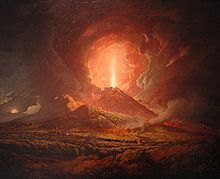
Mount Vesuvius is a somma-stratovolcano located on the Gulf of Naples in Campania, Italy, about 9 km (5.6 mi) east of Naples and a short distance from the shore. It is one of several volcanoes forming the Campanian volcanic arc. Vesuvius consists of a large cone partially encircled by the steep rim of a summit caldera, resulting from the collapse of an earlier, much higher structure.

Joseph Wright, styled Joseph Wright of Derby, was an English landscape and portrait painter. He has been acclaimed as "the first professional painter to express the spirit of the Industrial Revolution".

Sir William Hamilton,, was a British diplomat, antiquarian, archaeologist and vulcanologist. After a short period as a Member of Parliament, he served as British Ambassador to the Kingdom of Naples from 1764 to 1800. He studied the volcanoes Vesuvius and Etna, becoming a Fellow of the Royal Society and recipient of the Copley Medal. His second wife was Emma Hamilton, famed as Horatio Nelson's mistress.
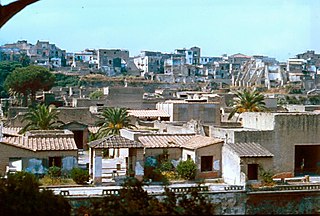
Ercolano is a town and comune in the Metropolitan City of Naples, Campania of Southern Italy. It lies at the western foot of Mount Vesuvius, on the Bay of Naples, just southeast of the city of Naples. The medieval town of Resina was built on the volcanic material left by the eruption of Vesuvius that destroyed the ancient city of Herculaneum, from which the present name is derived. Ercolano is a resort and the starting point for excursions to the excavations of Herculaneum and for the ascent of Vesuvius by bus. The town also manufactures leather goods, buttons, glass, and Lacryma Christi wine.

The Campanian volcanic arc is a volcanic arc that consists of a number of active, dormant, and extinct volcanoes in the Campania region of Italy. The Campanian volcanic arc centers on the bay of Naples and includes:

Daniel Parker Coke, was an English barrister and Member of Parliament.

A Philosopher Lecturing on the Orrery, or the full title, A Philosopher giving that Lecture on the Orrery in which a lamp is put in place of the Sun, is a 1766 painting by Joseph Wright of Derby depicting a lecturer giving a demonstration of an orrery – a mechanical model of the solar system – to a small audience. It is now in the Derby Museum and Art Gallery The painting preceded his similar An Experiment on a Bird in the Air Pump.

Romeo and Juliet: the Tomb Scene is a painting by Joseph Wright of Derby, completed by 1790, exhibited in 1790 and 1791, shown in the Derby Exhibition of 1839 in the Mechanics' Institute, and now displayed in Derby Museum and Art Gallery. The painting exhibits Wright's famed skill with nocturnal and candlelit scenes. It depicts the moment in Shakespeare's Romeo and Juliet when Juliet, kneeling beside Romeo's body, hears a footstep and draws a dagger to kill herself. The line is "Yea, noise? Then I'll be brief. O happy dagger!"

Virgil's Tomb is the title of at least three paintings completed by Joseph Wright of Derby between 1779 and 1785.

Indian Widow is a painting by Joseph Wright of Derby, completed in late 1783 or early 1784 and first shown in his solo exhibition in London in 1785. The painting is since 1961 in the collection of Derby Museum and Art Gallery.
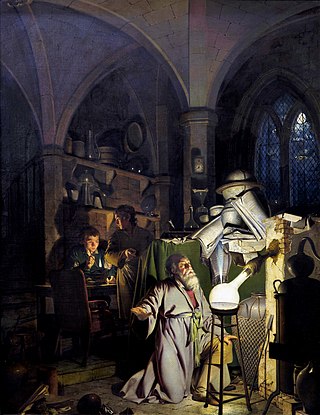
The Alchemist Discovering Phosphorus is a painting by Joseph Wright of Derby originally completed in 1771 then reworked in 1795. The full title of the painting is The Alchymist, in Search of the Philosopher's Stone, Discovers Phosphorus, and prays for the successful Conclusion of his operation, as was the custom of the Ancient Chymical Astrologers. It has been suggested that The Alchymist refers to the discovery of phosphorus by the Hamburg alchemist Hennig Brand in 1669. This story was often printed in popular chemical books in Wright's lifetime, and was widely known.
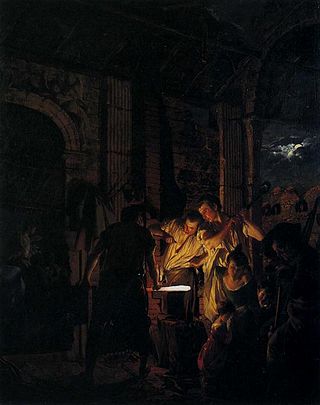
The Blacksmith's Shop is a recurring theme of five paintings by Joseph Wright of Derby. The version in his hometown was originally completed in 1771.

Earthstopper on the Banks of the Derwent is a painting by Joseph Wright of Derby originally completed in 1773. The scene shows a man digging at nighttime beside the River Derwent in Derbyshire.

The Captive King is a sketch by Joseph Wright of Derby completed in 1772 or 1773. It depicts the French nobleman Guy de Lusignan held prisoner by Saladin. The sketch is thought to have been a preparation for the now-lost painting Guy de Lusignan in Prison.
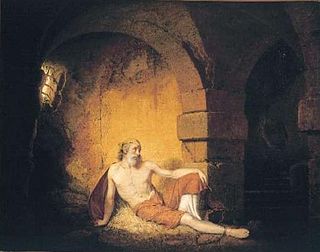
The Captive, from Sterne is a painting by Joseph Wright of Derby completed in 1774 and now in the National Gallery of Canada. Sterne's Captive, first exhibited by the artist in 1778, is a similar painting by Wright in the Derby Museum and Art Gallery. The latter painting resulted in a rare engraving, as its purchaser commissioned a print run of only twenty copies before the copper printing plate was destroyed. In 2012, Derby Museum commissioned another Captive painting from Emma Tooth.

Dovedale by Moonlight, 1784, is one of five paintings by Joseph Wright of Derby which uses the picturesque valley of Dovedale as its subject. These paintings were sometimes made as pairs with one showing the view by day and the other by moonlight. Wright admitted that he had not observed this scene directly, "Moon lights & fire lights are but a sort of work with me for I cant with impunity go out at night and study the former, & the latter I have seen but once, and at a time too, when I thought not of painting such effects."
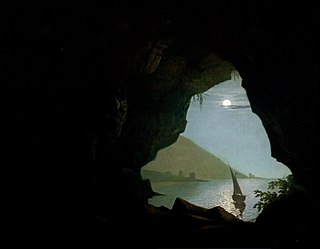
Grotto in the Gulf of Salerno is the subject of at least four paintings completed by Joseph Wright of Derby following his visit there in 1774. The paintings show the different lighting at different times of the day.

The Destruction of Pompeii and Herculaneum is a large 1822 painting by English artist John Martin of the eruption of Mount Vesuvius in 79 AD. It follows the pattern set by his previous successful painting, Belshazzar's Feast, which was another depiction of a dramatic scene from history delivered from an esoteric point of view. The work appeared to be lost from the Tate Gallery storerooms soon after it was damaged by the 1928 Thames flood, however it was rediscovered in 1973 and subsequently restored in 2011.
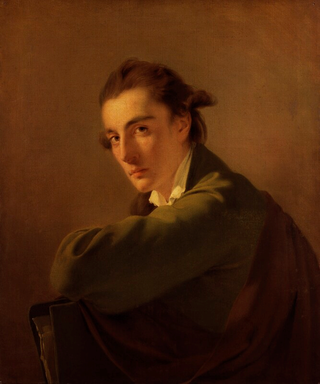
Richard Hurlstone or Richard Hurleston was a British portrait painter known for being a pupil of Joseph Wright of Derby. He went to Italy with Wright and his wife. He returned and died young after being hit by lightning on Salisbury Plain.

Vesuvius from Posillipo by Moonlight was painted by Joseph Wright of Derby in 1774. It is an oil painting of Mount Vesuvius in the distance, from the coastal shores of Naples at night. Dark grey smoke spews from the glowing red crater of the volcano and fills up the top right of the canvas, in contrast to the pale glow of moonlight to the left. Known as a "Painter of Light," Wright liked to play with highlights and shadows in his works and was most well known for his "Candlelight Pictures," landscape or genre scenes depicting dramatic contrasts between light and dark. Through utilizing this technique, Joseph Wright exhibits the sublimity of nature in Vesuvius from Posillipo by Moonlight as well as his other paintings of Mt. Vesuvius.

